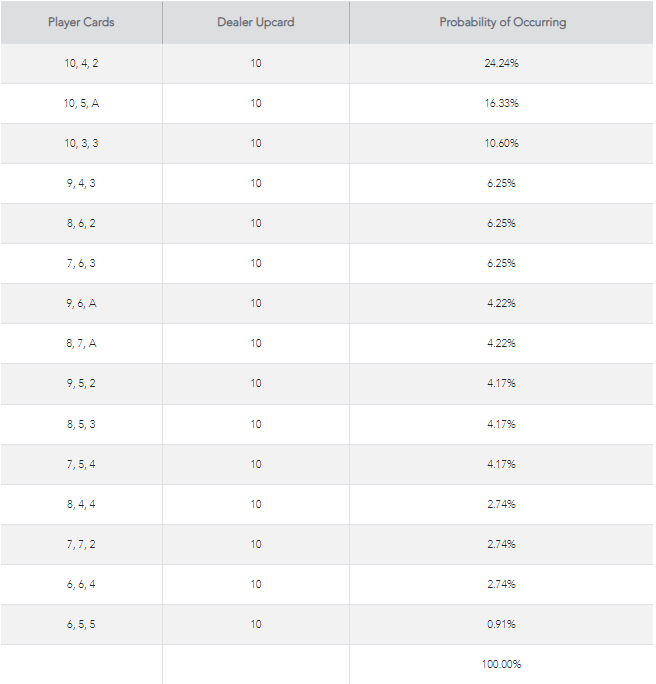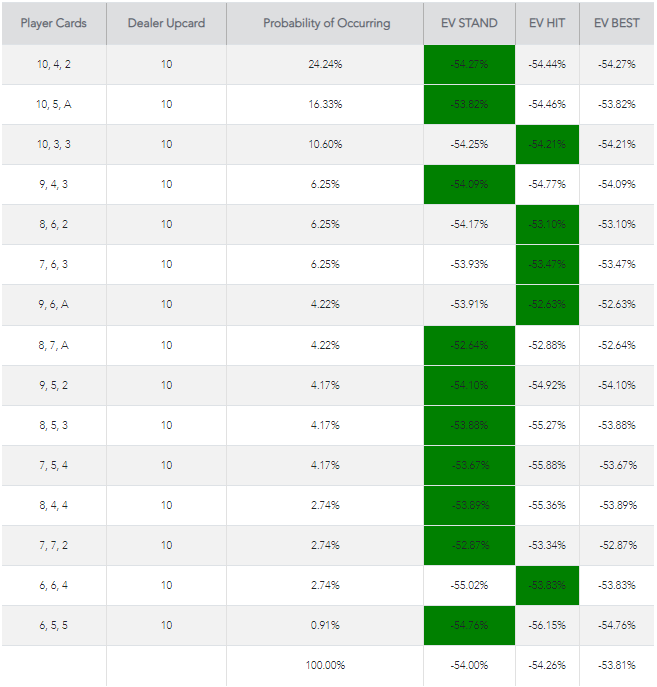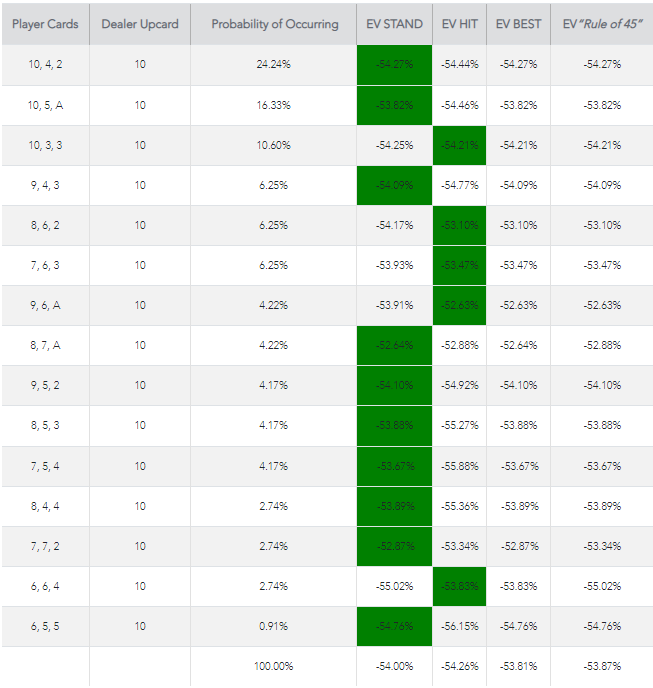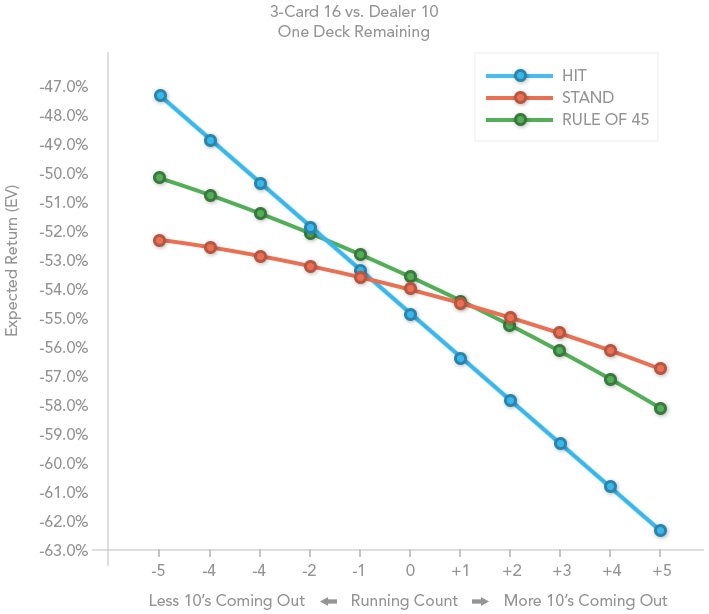|
In the main article we affirmed that Basic Strategy is to HIT a 2-card 16 versus seller 10, however assuming you are counting cards, utilizing Hi-Opt I, you ought to STAND assuming the count is +2 or higher. Most Basic Strategy tables that are distributed don't separate whether the player has 2, 3, 4 or more cards. That is on the grounds that in practically all cases, it doesn't make any difference. Nonetheless, the 3-card 16 versus vendor 10 is an exemption for that standard 온라인슬롯사이트. We should investigate. There are precisely 12 methods for showing up at a 3-card Hard 16 versus vendor 10 and be confronted with the Hit/Stand choice (note that Hitting Hard 11 versus 10 isn't one of these potential outcomes since you ought to Double Down with that hand): 1. Hit Soft 16 versus 10 and catch a 10 2. Hit Soft 17 versus 10 and catch a 9 3. Hit Soft 18 versus 10 and catch a 8 4. Hit Hard 6 versus 10 and catch a 10 5. Hit Hard 7 versus 10 and catch a 9 6. Hit Hard 8 versus 10 and catch a 8 7. Hit Hard 9 versus 10 and catch a 7 8. Hit Hard 10 versus 10 and catch a 6 9. Hit Hard 12 versus 10 and catch a 4 10. Hit Hard 13 versus 10 and catch a 3 11. Hit Hard 14 versus 10 and catch a 2 12. Hit Hard 15 versus 10 and catch an Ace This separates into 15 unique 3-card blends with some almost certain than others. Here are the variations and their recurrence, expecting a full twofold deck (104 cards): Presently we should utilize the Wizard of Odds hand mini-computer and add the EV's (normal returns) for every variation: As you can see from this table, the 3-card 16 versus 10 is such a near disaster that the best play relies upon which 3 cards you have. This is a lot nearer call than the 2-card 16 versus 10, which is plainly a hit no matter what the hand structure READ MORE. It is unreasonable for the greater part of us to play organization subordinate system and remember each of the 15 prospects, yet the weighted normal of every one of the 15 variations, in light of their likelihood of happening, favors remaining over hitting. This is likewise the situation for at least 4 card hard 16 versus 10. So albeit many great blackjack players retain the Basic Strategy table and Hit their 3-card 16 versus 10's, really the right Basic Strategy (Single Deck, Double Deck, and Multi-Deck) is to STAND: Notwithstanding, for the individuals who need to hopefully figure out somewhat more EV, there is a method for getting the greater part of the advantage of creation subordinate system yet with very little exertion. This better way is known as the "Rule of 45" and it is extremely simple to utilize. "Rule of 45": STAND in the event that your hand has a 4 or 5, generally HIT. The rationale behind the "Rule of 45" is straightforward. Assuming you HIT your hard 16, the ideal cards to get are the 4's and 5's. This choice is such a narrow escape that eliminating any of these great catch cards from the deck resembles a sudden death round and slants the equilibrium somewhat towards STAND. Presently we should add the "Rule of 45" to our table and see what occurs. You can see that the "Rule of 45" is noticeably flawed, yet merits integrating into your game. With practically no additional work, it will be nearly comparable to sythesis subordinate play. Note that the numbers in these tables are determined for a Double Deck game (104 cards). We will save you the subtleties here, yet multi-deck shoe games 온라인카지노 will have somewhat various numbers, but a similar main concern: Stand is superior to Hit, however the "Rule of 45" is shockingly better yet, and nearly comparable to organization subordinate procedure. Utilize the "Rule of 45" for generally hard 16's versus vendor 10, paying little heed to the number of cards you that have. All things being equal, it works for 2-card 16 versus 10 also. One final note on the "Rule of 45". Since you have this new sledge in your utility belt - don't go searching for nails! Just utilize the "Rule of 45" in two circumstances: Hard 16 versus Seller 10 Hard 12 versus Vendor 3 Presently how about we take a gander at the high level play for card counters. Here are the EV bends for HIT, STAND, and "Rule of 45" with one deck staying (52 cards). The level pivot is the Hi-Opt I Running Count (3, 4, 5, 6 worth +1; 10's worth - 1; Ace, 2, 7, 8, 9 unbiased). Since this chart is for precisely one deck staying, the even hub can likewise be utilized as True Count for different deck reason. In the first place, we see that as the deck gets more extravagant in 10's, the profits for all choices are deteriorating. That is on the grounds that we have a more serious gamble of busting assuming we HIT, and the vendor has a more noteworthy possibility having 20 assuming we STAND. Perhaps of the most terrible circumstance in the game is a hard 16 versus 10 with an exceptionally rich count (and likely a major bet in play). It could amaze a few that we see the blackjack "Rule of 45" has some worth in any event found in internet archive, for card counters. Assuming the count is 0 or - 1, you ought to in any case utilize the "Rule of 45". In the event that the count is not exactly - 1 you ought to HIT, and assuming the count is positive by any sum you ought to STAND.  Thus, despite the fact that you won't see it in most Basic Strategy tables, obviously the 3-card 16 versus 10 plays uniquely in contrast to the 2-card adaptation. Yet, commit no error about the "Rule of 45". It's anything but a wonder fix. You will in any case lose more often than not you get a 16 versus vendor 10. Notwithstanding, for your drawn out benefit, you should exploit every last edge where you can get it.
0 Comments
Leave a Reply. |
Archives
January 2022
Categories |







 RSS Feed
RSS Feed
